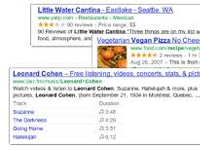
Does your website use rich snippets?
Our friend Google is at it again. In an attempt to remain loyal to their much publicised mantra that content is king they have now advised that your site may be penalised if you do not use ‘rich snippets’ as the rules demand.
I can already hear many site owners saying that they have no idea what rich snippets are and therefore do not care. Yet if you have not used these on your web sites you have potentially missed a lot of traffic and that obviously means sales.
What are rich snippets? Rich snippets are enhanced displays of web page results, including images and other extra information about the website. As Google puts it, “rich snippets are designed to summarise the content of a page in a way that makes it even easier for users to understand what the page is about in our search results.”
And this is what a rich snippet looks like in real life on a search results page in Google.

Obviously this extended information is likely to attract attention and stimulate higher click-through rates. Thus if you haven’t already heard of rich snippets or incorporated them in your site, you’re missing a great chance to attract extra organic traffic.
What data gets into rich snippets?
There are types of rich snippets you can use, depending on the type of your site’s content. These types differ for various search engines. Current rich snippets code supported by Google and highlighted are: Authors: Author photo, name and G+ connections; People: Photos, occupation, contact information; Products: Ratings, picture and price; Businesses & Organisations: Location and customer review. Some other results can also show up here. For example a resort’s rich snippets may include price ranges; Recipes: Photo, recipe, rating, time required and calorie content; Events: Event date, location and time; Music: Lyrics and link to play; Videos: preview thumbnail.
Now all this is very fine but the structure of all these bits of data have to follow Google’s rules. Rich snippets are the result of properly implemented structured data markup. By marking up your page data, you show the search engines and enable them to show users, some of the most important information on your pages.
And here’s where it gets a little more complicated as there is no easy on or off button inside your CMS that will implement structured data automatically, so you’ll have to apply some tech knowledge and read guidelines for the markup format you prefer.
At this point my article would have to become too technical for all but web masters.
So hot foot it to your designer and check out whether these have been implemented.
The reason for my highlights in the above list is to indicate the code entries that may have a whole string of structured code words for implementation. As always an attempt to spam the system would get you booted off real quick. For instance, in the good old days when the web and search engine were pups, a favourite ploy of designers was to include beneficial but invisible text. Text the human could not see but a computer could. That way the unscrupulous webmasters could lift the ranking of a web site without the use of relevant or suitable text. Later on as the web progressed that became know as black hat or spamming.
There are obvious errors in this type of structured coding that must be avoided lest one has ones web site penalised by Google and other search engines.
The first step should really be left to your webmaster as it again is somewhat technical.
Check out the structured data dashboard that can be found in your webmaster tools account. There you’ll see a list of the structured data types found on your site and any errors and technical issues related to them.
Similarly Google provides a rich snippets testing tool that lets you check your markup and make sure that Google can extract the structured data, including rich snippets markup, meta data, authorship information, and PageMaps, from your page. This tool will display a
whole range of information including a preview of how that page might appear in Google search results
The best way of safeguarding your page ranking would be to avoid making the following errors mentioned her particularly for those of you using a CMS system.
The first no-no for your rich snippets is the content, visible to search engines but hidden from your actual visitors. Even if the data you’d like to be displayed in the rich snippets does not match your design or isn’t really needed by your visitors be safer and never use CSS, value-title, display:none or any other means to hide this data, because this is what Google can potentially see as spamming.
Make sure the information represented in your structured data markup actually matches the page content, the products or events described thereon.
The main function of rich snippets according to Google is to make it easier to understand what a page is about. Rich snippets that are unrelated to your page content can be seen as misleading and manipulative in a page ranking sense.
Make sure rich snippets are built using one specific markup format. There are several choices. Otherwise Google may find it difficult to read your data correctly.
I realise some points are again somewhat technical but become an issue if you run a CMS, as quite a few of you do. Otherwise just ensure that your designer has taken care of these no-no’s. Some items of you structured data can include other items. For example, a restaurant review might include a person as the author of a review. In this case, you can convey the relationship between these types of data by correct usage of the code structure. Such errors are a technical issue that are not directly related to spamming but make it difficult for Google to correctly interpret your data and may potentially place you in jeopardy. All of these aspects can be found in Google’s webmaster tools which may be best left to your webmaster.
As web ranking today is extremely competitive the use of this technique is certainly worth while. Just realise that implementing structured data does not guarantee that your site will get a rich snippet displayed in search results. It just makes rich snippets possible. As always, the last word still rests with Google.

AccomNews is not affiliated with any government agency, body or political party. We are an independently owned, family-operated magazine.






